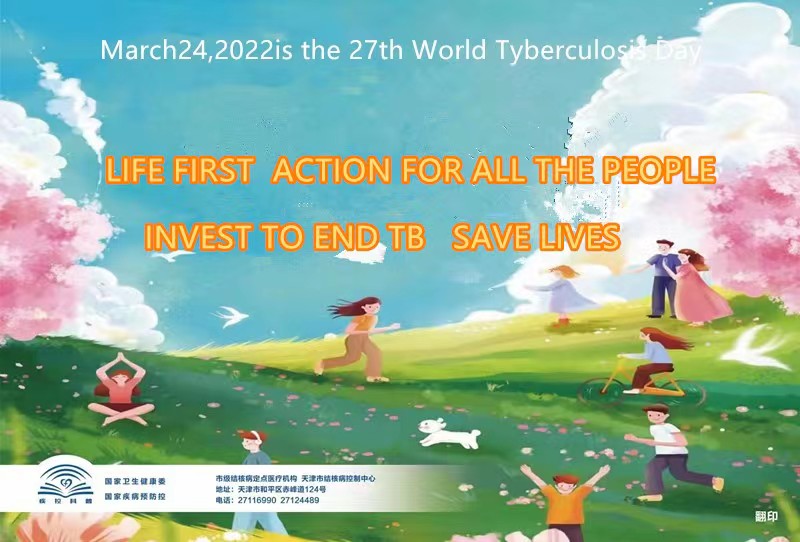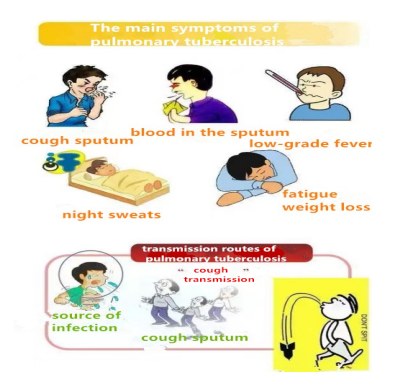World Tuberculosis Day

March 24, 2022 is the 27th World Tuberculosis Day. The theme of this year's TB Day is "Life First, Action for All to Share Health to End TB" . In order for the majority of patients and their families to gain correct health and prevention awareness, to enable them to actively prevent and control tuberculosis, Tianjin Medical University Cancer Hospital distributed various tuberculosis prevention and control materials in the outpatient hall on March 24 .
How much do you know about tuberculosis prevention and control?
What is tuberculosis?
1、Tuberculosis is a chronic respiratory infectious disease caused by Mycobacterium tuberculosis (referred to as Mycobacterium tuberculosis). Healthy people are mainly infected by inhaling droplets containing tuberculosis bacteria excreted by patients with infectious pulmonary tuberculosis. Tuberculosis can occur anywhere on the body except hair and nails, but the most common type of illness is pulmonary tuberculosis (about 80%). Tuberculosis that occurs in tissues and organs other than lung tissue is collectively referred to as extrapulmonary tuberculosis. Common extrapulmonary tuberculosis sites are the following: lymph node tuberculosis, bone and joint tuberculosis, tuberculous pleurisy, tuberculous meningitis, tuberculous peritonitis, intestinal tuberculosis, renal tuberculosis, epididymal tuberculosis, female genital tuberculosis (including fallopian tube, endometrium, ovarian tuberculosis).
2、The number of cases of and deaths from tuberculosis rank as the top two of China's statutory reportable Class A and B infectious diseases,.
3、If it is not detected in a timely manner or treated incompletely Tuberculosis, will cause serious harm to health, and may even cause respiratory failure and death, bringing a heavy economic burden to patients and families.

The main symptoms and transmission routes of pulmonary tuberculosis
1、Tuberculosis is a respiratory infectious disease that spreads easily.
2、Tuberculosis patients spread TB bacteria into the air through coughing, sputum, and sneezing, and healthy people may be infected by inhaling droplets containing TB bacteria.
3、People who share accommodation with tuberculosis patients or work and study in the same room are considered to be close contacts.
4、HIV-infected persons, immunocompromised persons, diabetic patients, pneumoconiosis patients, and the elderly are all vulnerable groups and should be checked for TB regularly every year.
Diagnosis of tuberculosis
1、Common symptoms of pulmonary tuberculosis are cough and sputum production. If these symptoms persist for more than 2 weeks, tuberculosis should be considered, and you should seek medical attention as soon as possible.
2、Pulmonary tuberculosis is accompanied by symptoms such as blood in the sputum, low-grade fever, night sweats, afternoon fever, chest pain, fatigue, weight loss, and difficulty breathing.
3、If you suspect that you have pulmonary tuberculosis, you should go to the local tuberculosis designated medical institution as soon as possible for treatment. There are designated TB medical institutions in counties (districts, flags), cities, provinces (districts, cities) and other regions.
How to reduce the spread of tuberculosis
1、Tuberculosis patients should avoid close contact with others and cover their mouth and nose when coughing or sneezing.
2、Tuberculosis patients should not spit anywhere, but should spit sputum into a covered spittoon with disinfectant; or if this is not possible, spit sputum into a sterile wet tissue or a sealed sputum bag.
3、Tuberculosis patients should, where possible, avoid going crowded public places. If they must go, they should wear masks.
4、Tuberculosis patients treated at home should have separate rooms from others, keep the room ventilated, and wear masks to prevent family members from being infected.
5、Tuberculosis is preventable and curable. Supplement nutrition, improve people’s immunity, and help prevent tuberculosis.
Treatment of tuberculosis
1、The treatment of pulmonary tuberculosis normally lasts about 6-8 months, and the treatment of drug-resistant tuberculosis is 18-24 months.
2、Where the standard treatment recommended by the doctor can be given, the vast majority of tuberculosis patients can be cured. Recover yourself while protecting your family.
3、Tuberculosis patients are prone to develop drug-resistant tuberculosis if they are not properly treated. Once the patient is resistant, the cure rate is low, the treatment cost is high, and the social harm is great.